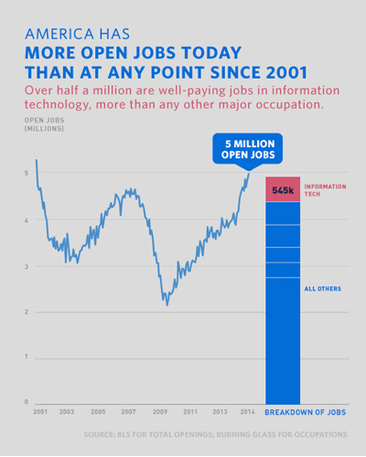
Yesterday, speaking to nearly 2,000 local leaders at the National League of Cities annual meeting, President Obama announced his TechHire initiative, a new campaign to work with communities to get more Americans rapidly trained for well-paying technology jobs.
The United States has about 5 million open jobs today, more than at any point since 2001. Over half a million of those job openings are in information technology (IT) fields like software development, network administration, user-interface design and cybersecurity – many of which did not even exist just a decade ago. The average salary in a job that requires IT skills – whether in manufacturing, advertising, retail, or banking – is 50 percent higher than the average private-sector American job.
In his remarks, the President emphasized that these open jobs are an economic development issue. When those jobs go unfilled, it’s a loss for American workers, for employers eager to hire, for our regional economies and for American competitiveness. Helping U.S. companies fill these critical jobs and empowering more Americans to train for and get these jobs is a key element of the President’s middle-class economics agenda.
TechHire is a multi-sector effort and call to action for local communities to collaborate in helping employers fill critical local IT job gaps by empowering a diverse array of Americans to rapidly gain the necessary technology skills, including using nontraditional training options like “coding bootcamps” and high-quality online courses.
The TechHire initiative is kicking off with a broad range of partners already on board:
And the President's visit to Georgia Tech today builds on the key themes he outlined yesterday with the launch of his Tech Hire initiative. We need to keep adapting our training options as new innovative models emerge which can reduce training time, costs, accessibility. The online Computer Science degree at Georgia Tech is a great example: it’s reducing cost and has the potential to do so without reducing quality.
Yesterday was just the beginning for TechHire. As the President highlighted at the National League of Cities, TechHire’s success will require many more to step up: Mayors and local leaders, employers and tech innovators, philanthropists and non-profits, workforce leaders and training providers, and everyone committed to unlocking the hidden talent in our communities.
The President ended his remarks with the remarkable story of LaShana Lewis. LaShana grew up in East St. Louis with a passion for computers. But without a college degree, she couldn’t even get an interview for a tech job. So she spent 12 years as a bus driver and in entry-level jobs. But with help of entrepreneurial new training organizations like LaunchCode which helped give her skills and vouched for her, she’s now an Associate System Engineer at MasterCard, and MasterCard wants more people like her to join their team.
LaShana’s story can be the story of so many others, and working together, we can ensure that it will be. We encourage everyone to reach out and discover your local tech community, whether through coding bootcamps, tech meetups, hack-a-thon gatherings, campus tech or entrepreneurship clubs and more. We hope you will take the time to learn more about TechHire at WhiteHouse.gov/TechHire and bring it to your community.
Megan Smith is the U.S. Chief Technology Officer. Jeff Zients is the Director of the National Economic Council.
https://www.whitehouse.gov/blog/2015/03/10/president-obama-launches-techhire
The United States has about 5 million open jobs today, more than at any point since 2001. Over half a million of those job openings are in information technology (IT) fields like software development, network administration, user-interface design and cybersecurity – many of which did not even exist just a decade ago. The average salary in a job that requires IT skills – whether in manufacturing, advertising, retail, or banking – is 50 percent higher than the average private-sector American job.
In his remarks, the President emphasized that these open jobs are an economic development issue. When those jobs go unfilled, it’s a loss for American workers, for employers eager to hire, for our regional economies and for American competitiveness. Helping U.S. companies fill these critical jobs and empowering more Americans to train for and get these jobs is a key element of the President’s middle-class economics agenda.
TechHire is a multi-sector effort and call to action for local communities to collaborate in helping employers fill critical local IT job gaps by empowering a diverse array of Americans to rapidly gain the necessary technology skills, including using nontraditional training options like “coding bootcamps” and high-quality online courses.
The TechHire initiative is kicking off with a broad range of partners already on board:
- 21 forward-leaning communities and over 300 employer partners. 21 regions, with over 120,000 open technology jobs and more than 300 employer partners, are announcing plans to work together on new ways to recruit and place applicants into jobs based on their actual skills and to create more rapid IT training opportunities. Get your community or employer involved by learning more here.
- New tools, resources, and commitments to support TechHire communities.Private sector leaders are announcing new tools and resources to encourage and expand continued innovation in technology training, with a focus on reaching under-served populations. For example, Capital One, through its FutureEdge initiative, $150 million FutureEdge initiative to help increase tech skills and hiring, while providing support tailored to the needs of local communities. LinkedIn will provide free data about the supply and demand of IT skills to help communities focus their efforts on in-demand jobs. To ensure high quality, A group of coding bootcamps have begun collaborating on how to transparently report completion and employment outcomes and they published an initial plan in a letter to the President today. A complete list of private sector commitments can be found here.
- $100 million in new Federal investments. The Administration will launch a $100 million H-1B grant competition by the Department of Labor to support innovative approaches to training and successfully employing individuals who face barriers to training and employment, including those with child care responsibilities, people with disabilities, disconnected youth, and limited English proficient workers, among others. This grant competition will support the growth of evidence-based strategies such as accelerated learning, work-based learning, and Registered Apprenticeships.
And the President's visit to Georgia Tech today builds on the key themes he outlined yesterday with the launch of his Tech Hire initiative. We need to keep adapting our training options as new innovative models emerge which can reduce training time, costs, accessibility. The online Computer Science degree at Georgia Tech is a great example: it’s reducing cost and has the potential to do so without reducing quality.
Yesterday was just the beginning for TechHire. As the President highlighted at the National League of Cities, TechHire’s success will require many more to step up: Mayors and local leaders, employers and tech innovators, philanthropists and non-profits, workforce leaders and training providers, and everyone committed to unlocking the hidden talent in our communities.
The President ended his remarks with the remarkable story of LaShana Lewis. LaShana grew up in East St. Louis with a passion for computers. But without a college degree, she couldn’t even get an interview for a tech job. So she spent 12 years as a bus driver and in entry-level jobs. But with help of entrepreneurial new training organizations like LaunchCode which helped give her skills and vouched for her, she’s now an Associate System Engineer at MasterCard, and MasterCard wants more people like her to join their team.
LaShana’s story can be the story of so many others, and working together, we can ensure that it will be. We encourage everyone to reach out and discover your local tech community, whether through coding bootcamps, tech meetups, hack-a-thon gatherings, campus tech or entrepreneurship clubs and more. We hope you will take the time to learn more about TechHire at WhiteHouse.gov/TechHire and bring it to your community.
Megan Smith is the U.S. Chief Technology Officer. Jeff Zients is the Director of the National Economic Council.
https://www.whitehouse.gov/blog/2015/03/10/president-obama-launches-techhire



 RSS Feed
RSS Feed